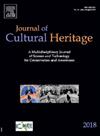Studying archaeological iron corrosion in the ground – Sample handling to avoid undesirable changes
IF 3.3
2区 综合性期刊
0 ARCHAEOLOGY
引用次数: 0
Abstract
This paper evaluates sampling and storage methods for the study of iron archaeological artifacts, aiming to minimize unwanted changes. The selected methods will be used to handle samples in multiple studies utilizing neutron and X-ray computed tomography (NX-CT) to monitor 3D transformations in artifacts during time series experiments. It is thus important to keep full control of the parameters that could induce such changes.
Two main approaches were tested: 1. imaging iron nails with their surrounding soil to maintain quasi-in-situ conditions and 2. imaging iron nails with a limited amount of soil to improve imaging resolution, also applicable for fully excavated nails. The highly variable soil moisture levels caused option 1 to be discarded, due to difficulties in reconstructing the tomograms. For the nails from setup 2, image reconstruction was successful. Additionally, to prevent unwanted changes occurring during storage, various short-term anoxic storage options were tested. Results showed that keeping the samples in Intercept® bags with RP-K oxygen scavengers and shortening the waiting time between experiments effectively minimized alterations like moisture loss, microcracks, and material displacement. In contrast, prolonged storage in the imaging sample holder caused noticeable unwanted changes.
The findings emphasize the importance of optimized handling and storage to distinguish changes caused by external factors of interest. These protocols ensure accurate assessments of post-excavation conditions and conservation treatments, providing valuable insights into the preservation of archaeological iron artifacts and advancing the study of long-term corrosion processes.
研究考古铁在地面上的腐蚀-样品处理以避免不希望的变化
本文评估了铁考古文物研究的采样和存储方法,旨在最大限度地减少不必要的变化。所选择的方法将用于处理多个研究中的样品,利用中子和x射线计算机断层扫描(NX-CT)在时间序列实验期间监测工件的3D变换。因此,必须完全控制可能引起这种变化的参数。主要测试了两种方法:1。成像铁钉与周围土壤保持准原位条件;采用少量土对铁钉进行成像,提高成像分辨率,也适用于全开挖铁钉。由于重建层析图的困难,高度可变的土壤湿度水平导致选项1被丢弃。对于安装2的钉子,图像重建成功。此外,为了防止在存储过程中发生不必要的变化,测试了各种短期缺氧存储选项。结果表明,将样品保存在带有RP-K氧清除剂的Intercept®袋中,并缩短实验之间的等待时间,有效地减少了水分损失、微裂纹和材料位移等变化。相反,在成像样品支架中长时间存储会引起明显的不必要的变化。研究结果强调了优化处理和储存的重要性,以区分由外部因素引起的变化。这些协议确保了对挖掘后条件和保护处理的准确评估,为考古铁制品的保存提供了有价值的见解,并推进了长期腐蚀过程的研究。
本文章由计算机程序翻译,如有差异,请以英文原文为准。
求助全文
约1分钟内获得全文
求助全文
来源期刊

Journal of Cultural Heritage
综合性期刊-材料科学:综合
CiteScore
6.80
自引率
9.70%
发文量
166
审稿时长
52 days
期刊介绍:
The Journal of Cultural Heritage publishes original papers which comprise previously unpublished data and present innovative methods concerning all aspects of science and technology of cultural heritage as well as interpretation and theoretical issues related to preservation.
 求助内容:
求助内容: 应助结果提醒方式:
应助结果提醒方式:


